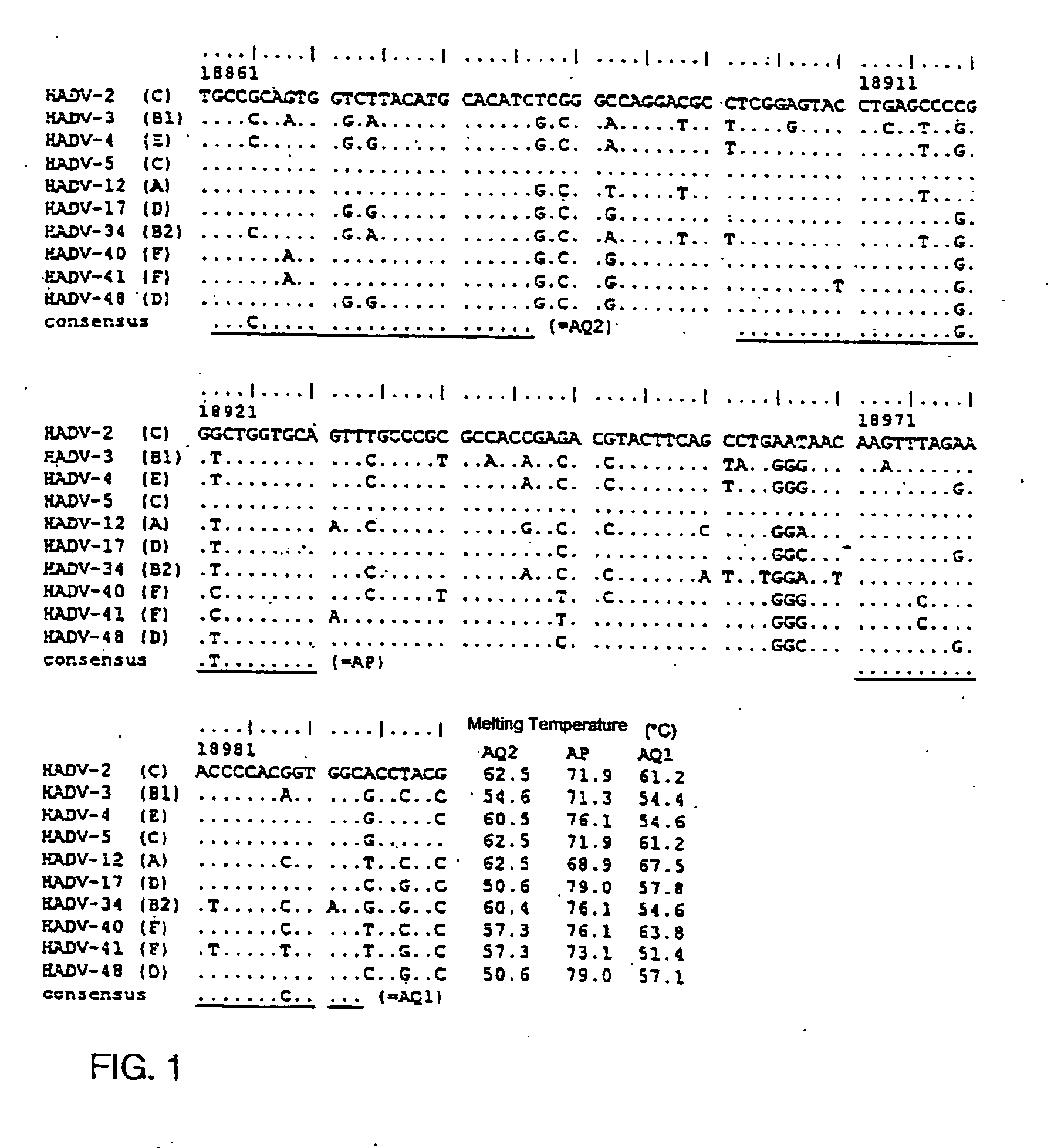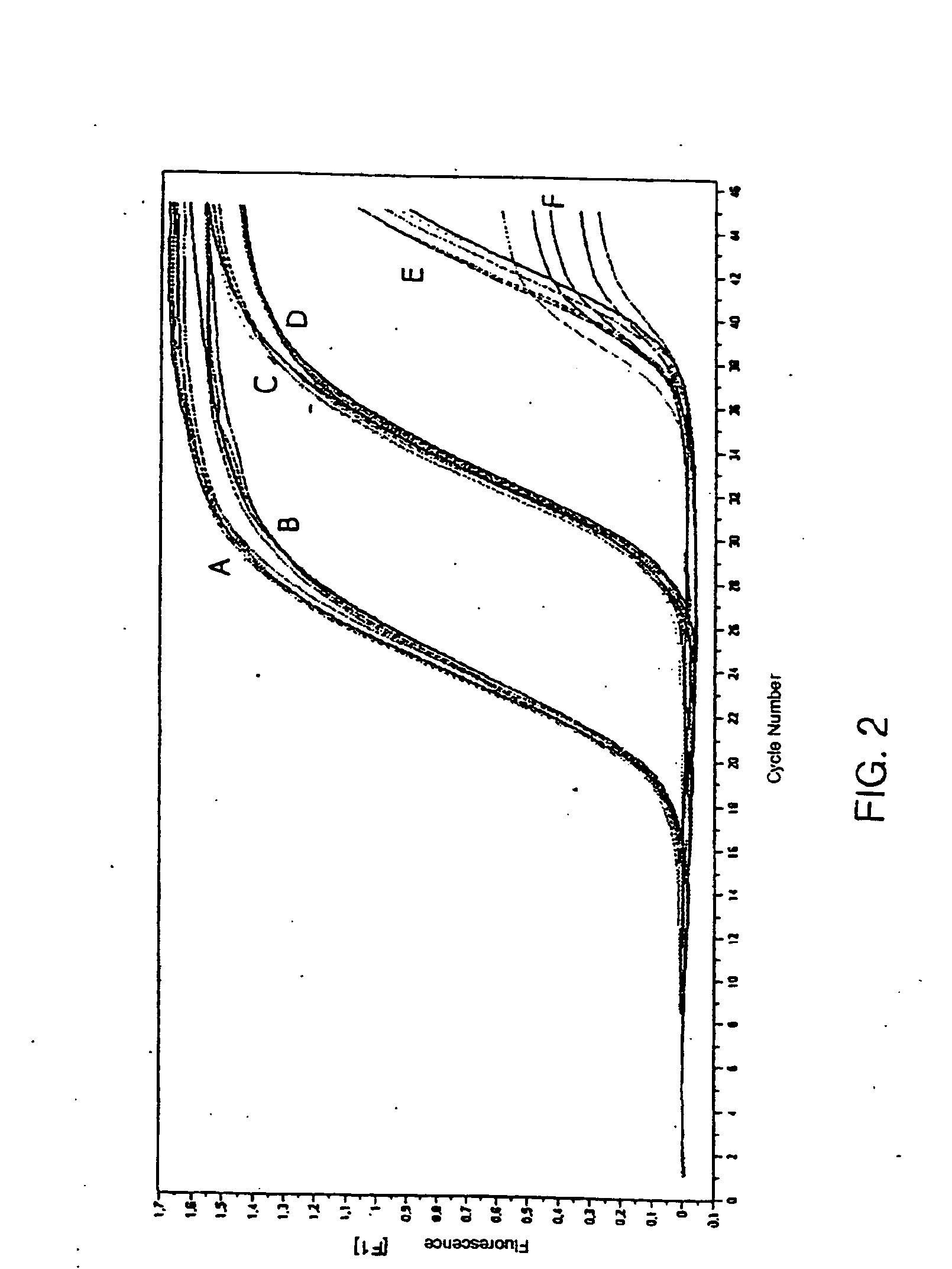Agents and methods for detecting human adenoviruses
a technology of human adenovirus and detection methods, applied in the field of primers and probes, can solve the problems of slow and inefficient cultivation of hadv types, significant load of hadv of various serotypes, and up to three weeks for any cytopathic effects to develop
- Summary
- Abstract
- Description
- Claims
- Application Information
AI Technical Summary
Benefits of technology
Problems solved by technology
Method used
Image
Examples
example 1
HAdV Quantification, Standard Plasmid, and Available Viruses
[0140] To prepare a standard for positive control, a HAdV-2 PCR amplicon (nt. 18856-19137 of the HAdV-2 sequence) was cloned into a pGEM-T Easy plasmid vector (Promega, Madison, Wis.). The plasmid DNA was purified out of E. coli using the Nukleobond 100 Kit (Macherey and Nagel, Germany) and sequenced to verify that the cloned HAdV-2 sequence was identical to the HAdV-2 prototype Gene bank sequence (#J01917). The plasmid concentration was determined using photometry at 260 nm and converted to genome equivalents (copies per ml), since the molecular weight of the plasmid is known.
[0141] For this test series of the HAdV serotypes, A549 cells (Graham 293 cells for HAdV-40 and HAdV-41) were infected with the HAdV prototype strains. For over 50% CPE (cytopathic effect) the cells were freeze-dried and the DNA was extracted from 200 μl of the lysate using the Qiagen Blood Kit (Qiagen, Hilden, Germany). We tested prototype virus st...
example 2
Design of Primers and Probe
[0142] The design process for a primer pair for amplification of the DNA of all 51 serotypes of the genus HAdV was as follows: Five already completely sequenced, type 2 (Species (Genus) human Adenovirus C, Gene bank #J01917), 5 (Species human Adenovirus C, #M73260), 12 (Species human Adenovirus A; #X73487), 17 (Species human Adenovirus D, #AF108105), and 40 (Species human Adenovirus F, Gene bank #L19443) were aligned using the software package clustalX (Version 1.8) (see Thompson, J. D., D. G. Higgins, and T. J. Gibson. 1994. CLUSTAL W: improving the sensitivity of progressive multiple sequence alignment through sequence weighting, position-specific gap penalties and weight matrix choice. Nucleic Acids Res. 22(22):4673-80).
[0143] Several highly conserved regions were identified in the hexon gene, whereby these regions not only allow the specific binding of the primers but also that of the labeled probe. Since additional data on the hexon gene sequence of...
example 3
The TaqMan PCR
[0147] The TaqMan PCR was carried out in sealed glass capillaries with a total reaction volume of 20 μl using the LightCycler (LC, Roche Diagnostics, Mannheim, Germany). The FastStart Hybridization Kit (Roche) was used to prepare a PCR master mix. As HAdV-specific primers we used the primers Adenoquant 1 (AQ1, SEQ ID NO. 1) and Adenoquant 2 (AQ2, SEQ ID NO. 2). The probe (AP, SEQ ID NO. 3) was labeled with FAM (Carboxyfluorescein) as fluorescent dye at the 5′ end and with TAMRA (Carboxytetramethylrhodamine) as fluorescent quencher at the 3′ end. All oligonucleotides were synthesized, labeled, and purified by Eurogentec (Seraing, Belgium). The probe, the primers, and magnesium chloride were added to the master mix in amounts to achieve these final concentrations: probe 0.4 mM, each primer 0.5 mM, and magnesium chloride 3 mM. Also added to the master mix was thermolabile Uracil DNA Glycosylase (UNG, 1 U / reaction; Roche, Mannheim, Germany). Each capillary was filled with...
PUM
| Property | Measurement | Unit |
|---|---|---|
| volume | aaaaa | aaaaa |
| concentration | aaaaa | aaaaa |
| melting temperatures | aaaaa | aaaaa |
Abstract
Description
Claims
Application Information
 Login to View More
Login to View More - R&D
- Intellectual Property
- Life Sciences
- Materials
- Tech Scout
- Unparalleled Data Quality
- Higher Quality Content
- 60% Fewer Hallucinations
Browse by: Latest US Patents, China's latest patents, Technical Efficacy Thesaurus, Application Domain, Technology Topic, Popular Technical Reports.
© 2025 PatSnap. All rights reserved.Legal|Privacy policy|Modern Slavery Act Transparency Statement|Sitemap|About US| Contact US: help@patsnap.com


